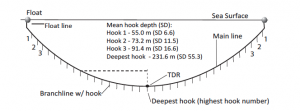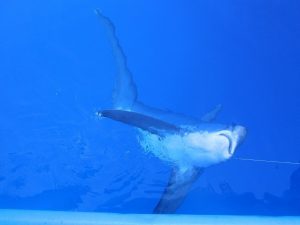Economic vs. Conservation: Trade-offs between Catch, Bycatch, and Landed Value in the American Samoa Longline Fishery
By Laurel Zaima, RJD Undergraduate Intern
Commercial fisheries have prioritized maximum economic profit over the ecological distresses caused by their fishing practices. Consequently, unsustainable fishing practices hook high amounts of bycatch in relation to the amount of the target species. Bycatch are the animals that are accidentally caught and discarded due to lack of value, insufficient size, damaged, or regulatory reasons. Bycatch has detrimental effects on the populations of a diversity of marine species; therefore, has altered ecological relationships and the economics of commercial fisheries. A seemingly obvious solution to this threat would be the implementation of commercial fishing gear that mitigates bycatch. However, this resolution results in trade-offs among the catch, bycatch, and landed value. In their scientific research paper, Trade-offs among Catch, Bycatch, and Landed Value in the American Samoa Longline Fishery, Watson and Bigelow (2013) assess the benefits and disadvantages of modifying longlines to reduce bycatch in the American Samoa longline.
Longline fisheries often modify their fishing gear to the behavior characteristics of their target species in order to have the most catch per unit effort. Shallow hooks (<100 m) would be set to target yellowfin tuna and billfish, where as, deep hooks (>100 m) will be set to target albacore and bigeye tuna. The U.S. longline fishery based in American Samoa target a majority of their valued species in deep water, such as albacore. Unfortunately, their current fishing practices are not modeled after the behavior of their target species and have led them to catch tons of bycatch. Non-targeted species, such as green sea turtles, silky sharks, and oceanic whitetip sharks spend majority of their life near the surface, and are susceptible to longlines set in shallow waters (<100 m) or hooks passing through the surface during the setting or retrieval of hooks. The elimination of shallow water hooks or the redistribution of shallow hooks to deeper depths could help reduce bycatch and increase the landing of target species.
Watson and Bigelow (2013) modified the American Samoa fishery’s longline fishing gear by removing the shallowest hooks per section of the longline or by hypothetically redistributing the shallowest hooks to a deep position. In the first three scenarios, Watson and Bigelow (2013) eliminated the first hooks, the first and second hooks, and the first, second, and third hooks at both ends of each section. In the other three scenarios, the hooks were theoretically rearranged into deeper depths by extending the number of sections.

A Longline section has about 23-36 hooks between two floats, and each longline has up to ~100 sections. In Watson and Bigelow’s (2013) study, they modified the longline by either eliminating the shallowest hooks or by hypothetically reallocating them into deeper positions.
They found that there is a decrease in all catch, including a significant decrease in bycatch, by eliminating shallow hooks from longline sections. By reallocating the shallow hooks to deeper positions, there was an effective bycatch reduction while still sustaining target species landings. In terms of economic profit, it would be most beneficial for longline fisheries to redistribute their hooks to deeper positions because it increases their chances of catching the most valuable species. Specifically, there was an increase in catch of the three most valuable species in the American Samoa fishery, albacore, yellowfin, and bigeye tunas, with the redistribution of hooks. The increased catch of these 3 species alone would increase the total annual landed value by an estimated U.S. 1.4 million dollars.
In terms of conservation benefits, the removal of the first three shallow water hooks reduces bycatch for a variety of species, including 25 species of fish, sea turtles, billfishes, and some shark species. Although there are ecological advantages to the elimination or redistribution of the shallow water hooks, there are some economic trade-offs. In the scenarios of elimination and redistribution, there is a loss in landed value for wahoo, billfishes, and dolphinfish. However, the catch of tuna would probably compensate for the loss value of these species. There is also a possibility of an unintentional trophic cascade with decreased catches of billfish (tuna predators) because it could increase the predation on a fishery targeted tuna species. Another potential trade-off would be the increased bycatch of deeper dwelling vulnerable species, such as shortfin mako sharks and the bigeye thresher sharks.
Watson and Bigelow’s (2013) modifications to the hook distribution on longlines should be considered for implementation by longline fisheries that target deeper residing species. Depending on the location of the fishery, these longlines could have varying economic and ecological results. Nonetheless, adjusting the longline hooks to specifically target a species is the most feasbile way to reduce bycatch while sustaining target species catches.

